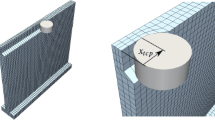Abstract
Oscillator models provide an efficient approach for simulating the dynamic behaviour of the machine, tool, or workpiece. In their application, however, these models are usually limited to describing the vibration behaviour at one specific position since they do not contain any information about the structure of the machine tool or the workpiece. Additionally, the variation in time dependent parameters caused by the material removal process is not taken into account. In this paper, an adapted model, which takes the position- and time-dependent modal parameters during NC milling into account, is presented and its experimental validation with respect to the machining of thin-walled components is discussed.








Similar content being viewed by others
References
Brecher C, Esser M, Witt S (2009) Interaction of manufacturing process and machine tool. CIRP Ann Manuf Technol 58(2):588–607
Kakinuma Y, Sudo Y, Aoyama T (2011) Detection of chatter vibration in end milling applying disturbance observer. CIRP Ann Manuf Technol 60(1):109–112
Altintas Y, Brecher C, Weck M, Witt S (2005) Virtual Machine Tool. CIRP Ann Manuf Technol 54(2):115–138
Altintas Y, Weck M (2004) Chatter stability of metal cutting and grinding. CIRP Ann Manuf Technol 53(2):619–642
Biermann D, Surmann T, Kehl G (2008) Oscillator model of machine tools for the simulation of self excited vibrations in machining processes. In: 1st international conference on process machine interactions, Hannnover, pp 23–29
Smith KS, Schmitz TL (2009) Machining dynamics: frequency response to improved productivity. Springer, Berlin
Klocke F, Kratz S, Veselovac D (2010) FEM simulation and experimental evaluation of a thin walled components dynamic behaviour. In: 2nd international conference on process machine interactions, Vancouver
Gonzalo O, Peigne G, Gonzalez D (2006) Thin-walled features high speed machining simulation. In: CIRP international workshop on modeling of machining operations, Bled, pp 123–130
Denkena B, Schmidt C (2007) Experimental investigation and simulation of machining thin-walled workpieces. Prod Eng Res Devel 1(4):343–350
Henninger C, Eberhard P (2008) Analysis of dynamic stability for milling processes with varying workpiece dynamics. J Appl Mat Mech 8(1):10367–10368
Atlar S, Budak E, Özgüven HN (2008) Modeling part dynamics and chatter stability in machining considering material removal. In: 1st international conference on process machine interactions, Hannover
Biermann D, Kersting P, Surmann T (2010) A general approach to simulating workpiece vibrations during five-axis milling of turbine blades. CIRP Ann Manuf Technol 59(1):125–128
Hartung F, Insperger T, Stepan G, Turi J (2006) Approximate stability charts for milling processes using semi-discretization. Appl Math Comput 174(1):51–73
Surmann T, Enk D (2007) Simulation of milling tool vibration trajectories along changing engagement conditions. Int J Mach Tool Manuf 47(9):1442–1448
Arizmendi M et al. (2009) Model for surface topography prediction in peripheral milling considering tool vibration. CIRP Ann Manuf Technol 58(1):93–96
Surmann T, Biermann D (2008) The effect of tool vibrations on the flank surface created by peripheral milling. CIRP Ann Manuf Technol 57(1):375–378
Haake F, (1983) Einführung in die theoretische Physik. Physik Verlag, Weinheim
Acknowledgments
This work is based on the research projects BI 498/5-2 “‘Entkoppelte Oszillatormodelle als effizientes Ersatzsystem zur Bestimmung von Stabilitätsdia-grammen für die NC-Fräsbearbeitung dünnwandiger Bauteile” and TR 10 TP T3 “Erweiterung der Frässimulation zur Bearbeitung von Leichtbaukomponenten unter Berücksichtigung von Werkzeug- und Maschineneigenschaften” which are kindly funded by the German Research Foundation (DFG).
Author information
Authors and Affiliations
Corresponding author
Rights and permissions
About this article
Cite this article
Biermann, D., Surmann, T. & Kersting, P. Oscillator-based approach for modeling process dynamics in NC milling with position- and time-dependent modal parameters. Prod. Eng. Res. Devel. 7, 417–422 (2013). https://doi.org/10.1007/s11740-013-0454-6
Received:
Accepted:
Published:
Issue Date:
DOI: https://doi.org/10.1007/s11740-013-0454-6




